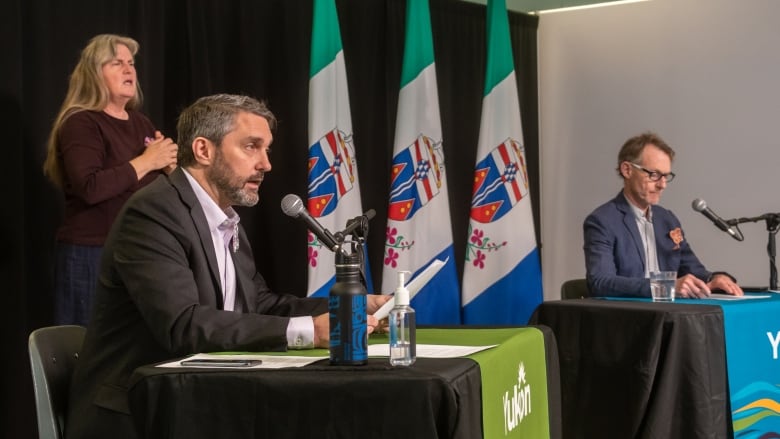'We can't keep Yukon cocooned': Territory to open borders to B.C., N.W.T., Nunavut residents July 1
Yukon prepared for new cases of COVID-19 after Phase 2 opens territory to more travellers

As expected, restrictions at the Yukon and B.C. border will ease for B.C. residents to visit Yukon starting July 1, the start of the second phase of Yukon's COVID-19 recovery plan.
In a press conference Wednesday, Premier Sandy Silver and Chief MedicalOfficer of Health Dr. Brendan Hanley announced that residents of the N.W.T. and Nunavut would also be allowed entry to Yukon, as long as they travelled directly to the territory through either the N.W.T., B.C. or by flying from Nunavut.
There will be noself-isolation requirement in Yukon for those visitors, or for Yukoners returning from any of those three approved jurisdictions.
"We know for many reasons that we can't keep Yukon cocooned from the rest of the country until a vaccine is found," Hanley said. He said the closure of Yukon's borders came with a cost that mustbe balanced against the risk of easing border restrictions.
Travellers to Yukon will be required to provide proof of residency, and they will not be allowed to have travelled through any unapprovedjurisdiction, even briefly, before arriving in Yukon. They will also have a "written declaration and a commitment to fulfil at the border," Hanley said.

There has not been a new case of COVID-19 in the territory since April 20, and all of Yukon's 11 cases are now recovered. But with increased visitors to the territory comes the risk of the reintroduction of cases of COVID-19 in the Yukon.
Hanley said the territory is not only prepared for that possibility, but expects it as a trade-off for increased mobility and the slow return to "normalcy."
"We will see more cases of COVID-19 in Yukon," Hanley said. "What's important here is to make sure that all our vulnerable sites and people are protected ... I'm confident that we can address the next cases in the same manner of prompt containment and care for the patientsthat we demonstrated for the first 11 cases."
Neither the N.W.T. nor Nunavut have, to date, announced plans to reciprocateon this arrangement. Residents of those territorieswho visit Yukon will need to self-isolate for 14 days upon their return home.
Upping enforcement
Phase 2 brings other easements of COVID-19 restrictions. Restaurants will be able to return to 100 per cent capacity if they are able to reach that capacity while respecting rules around social distancing that remain in effect.
Neither Hanley norSilver believe all restaurants will be able to achieve that.
"If you have the ability to maintain social distancing and open up to 100 per cent capacity, then you can do that. It's just that a lot of restaurants won't have that ability," Silver said.
"This is all about spacing," Hanley said, expandingon Silver's comment."It's not always going to be possible for a restaurant to get to 100 per cent capacity."
Silver acknowledged his government has heard complaints of overcrowded bars and restaurants, and of people disobeying requirements around social distancing. He said he's also aware of complaints about travellers with U.S. plates, who should be on their way directly to Alaska, making unauthorized stops in Yukon.
"What we ask people to do is not engage with travellers, but if you feel somebodyis not adhering to the provisions, the recommendations and the requirements, we do have emails and phone numbers to send that information to," Silver said.
"It's up to us to make sure that we do as much as we can do to up the enforcement, and that's what we intend to do."
Silver added that, generally speaking, Alaskans travelling through the territory have abided by the rules.
'Safe six'
For Phase 2 to work, Hanley said Yukoners must remain vigilant. Although the threat of COVID-19 is being managed well in the territory, it isconceivable that a spike in cases could mean a return to stiffer restrictions.
"Don't cheat on the safe six," Hanley said.
The "safe six" are: to cough and sneeze into an elbow or a tissue, to stay two metres apart from those who are not in a household bubble, to be respectful when travelling, to stay at home if unwell, to self-isolate if required and to wash one's hands frequently and correctly.
"If we all follow these six steps, we can greatly reduce our own risk and the risk to others," Silver said.
Other modified restrictions as of July 1 include:
- Outdoor gatherings of up to 50 people are allowed, provided social distancing and other precautions are maintained.
- Swimming pools can be reopened, with an approved operational plan.
- Buskers and non-food items will again be allowed at community markets.
The Fireweed Market will also be open Thursday.
"Life is moving toward some some semblance of normalcy, but that normalcy does not mean that COVID-19 is going away," Hanley said.
"The new reality is that we are to behave differently in order to keep ourselves and other safe from the spread of COVID-19."
Hanley said the easing of border and other restrictions is a "calculated risk."
"This is time to get serious and committed," he said, referring to individual and collective responsibility.












_(720p).jpg)


 OFFICIAL HD MUSIC VIDEO.jpg)
.jpg)



























































































